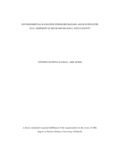| dc.description.abstract | Coal is extensively used in the generation of energy, the byproducts of which have profound applications in the building and construction industry and in agriculture. It is no doubt that the exploitation of coal deposits in Kenya will spur the development of infrastructure, create employment and significantly influence the socio-economic structure. However, the mining process also has its negative effects to the environment, and the public in general; such as radiation exposure.
In general, living organisms are continuously exposed to cosmic and other terrestrial ionizing radiation. However, exposures vary between localities due to altitude and geological characteristics. Other human activities also contribute to increased exposures to ionizing radiation. These include; metals mining, coal fired power plants, phosphate rock mining and their subsequent use in fertilizers, natural gas production, gas mantles, luminescent dials, medical diagnostics and treatment, industrial radiography and air travel are some of the activities that significantly modify the environmental exposure to ionizing radiation. In general, coal excavation among other mining activities tend to increase the risk of exposure to harmful gamma radiation. Studies on exposures to high radioactivity levels indicate detrimental effects.
The aim of this study therefore, was to assess the radiation hazard risks associated to the coal deposit in the Mui Basin Block C prior to the start of mining activities. This study evaluated the radiation levels in soil samples from Yoonye, Kathonzweni and Kateiko within the coal rich block C that covers approximately 131.5 km2 of the Mui basin in Kitui County. Specifically, the study was undertaken to evaluate the background radiation levels and radionuclide concentration levels in these areas. Forty-two (42) soil samples were collected between 19th and 22nd August 2013 from Block C at between 10 to 20 cm depth for gamma spectroscopy analysis. The samples were crushed, sieved, weighed and stored in plastic sealed containers for 21 days before counting was performed.
Radionuclide activity analysis was done using gamma-ray spectrometer HpGe detector Model No. CPVD530-30185 SN 2489 with a 30% efficiency, 1.8 KeV (FWHM) resolution at 1.33 MeV peak of Co-60 and MAESTRO PC based software for analysis of the spectral data. The activity concentration of 232Th was found to be between 9.7±5.6
vi
and 130±5 Bqkg-1, 238U was between 14. 2 ± 2.9 and 75. 9 ± 4.2 Bqkg-1 and 40K was between 348±18 and 1678 ±73 Bqkg-1. More than 80% of the soil samples measured in this study had activity concentrations higher than the reported world average values of 30, 35 and 300 Bqkg-1 for 238U, 232Th and 40K respectively. The gamma absorbed dose was found to be between 48 and 173 nGyhr-1 with more than 90% of the soils sampled having values exceeding the estimated world absorbed dose average of 60nGyhr-1. The radium equivalent dose was determined to range between 98.31 and 344 Bqkg-1which is below the ICRP recommended threshold value of 370 Bqkg-1. The internal hazard index ranged from 0.32 to 1.14 whereas the external exposure hazard indices ranged between 0.27 to 0.96. About 4 soil samples from the sampled region had internal hazard indices above unity.
There were no statistically significant differences in 232Th and 238U activity concentrations of soils sampled from Yoonye and Kathonzweni (p232Th = 0.821, p238U = 0.937), Yoonye and Kateiko (p232Th =0.86, p238U = 0.53), Kateiko and Kathonzweni (p232Th = 0.76, p238U = 0.42) all at p< 0.05 respectively. However, there were significant differences in the 40K activity concentration levels between soil samples from Yoonye and Kathonzweni (p = 0.026) at p<0.05. In general, soil samples from Yoonye had much higher 40K activity concentration compared to those from Kathonzweni and Kateiko.
In regard to the radiation exposure hazard indices and radium equivalent, the absorbed dose and the annual effective dose equivalent, the difference was not significant at p<0.05.
In summary, the study has enabled determination of the radioactivity levels in Block C of the Mui Basin whose levels currently do not pose radiation health hazard risk. | en_US |



